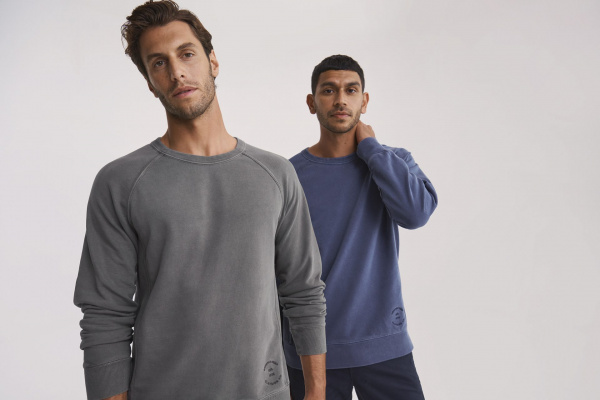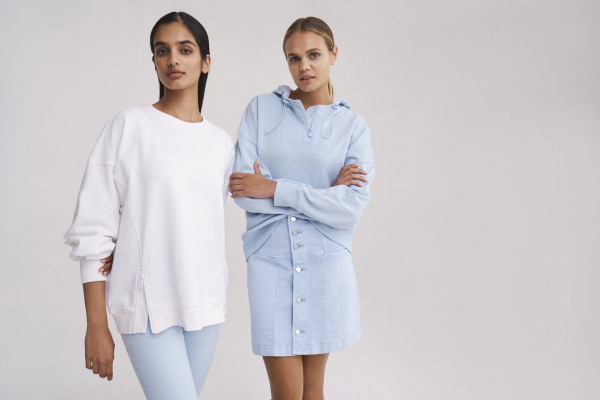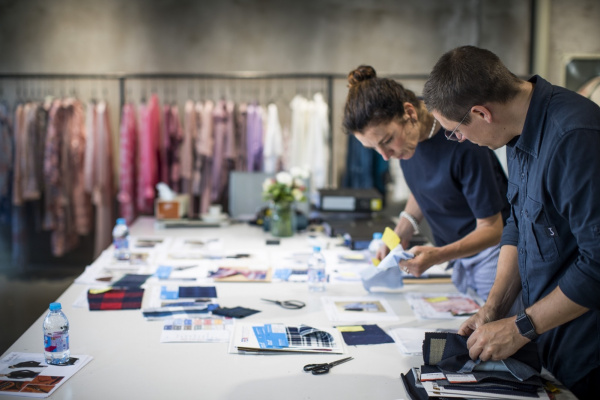
The journey to circularity is complex, but there is hope. Image Country Road
- Fashion
Journey towards circular fashion
Fifty shades of green (fashion)
In partnership with Country Road
We’ve been talking a lot about the circular economy here at Green + Simple, specifically its application to the fashion industry. Honestly, after having a fairly decent base of knowledge, given what we do for a job, and then researching for hours for this article, there’s a lot to unpack.
A way out of our current linear system of production – that is, we take materials from the Earth, make products from them, and eventually throw them away as waste – feels like a mighty big undertaking for individuals and more significantly, the brands we know, love and wear. When globally, the fashion industry is responsible for around 40 million tonnes of textile waste a year, most of which is either sent to landfill or incinerated, circular fashion is critical if the industry is to align with global climate objectives and its own commitments on sustainable materials.
Is sustainable fashion the same as circular fashion?
No. But with so many buzzwords in the industry, it can get a little confusing. First up we have sustainable fashion, which is the overarching umbrella that refers to the impact of fashion on the environment and covers issues such as pollution, water use and waste production. While it’s all about creating products that have the lowest possible negative impact on the environment, brands are embracing circularity in their business to attain sustainability.
Regenerative by nature, at its heart circular fashion is about systems change with the overall goal to eliminate waste in the fashion industry cycle completely by advocating for reduction, reuse, repair, and recycling. But not only that, it creates jobs, and it drives innovation. One of the most important levers the fashion industry can pull to reduce its environmental impact is closed-loop recycling. It caps the mining of virgin raw materials, keeps materials in play for as long as possible and recognises the resource constraints of living on a planet with finite resources.
The challenges and opportunities
There’s no one-size-fits-all circular business model, and because of that, this is an evolution rather than a movement. For fashion brands, it’s about unpicking their operations and figuring out what fits well with their current model. From production right through to the returns process, most need the support of focused partners who specialise in a particular area.
For example, many fashion brands are currently working hard to reduce waste through their manufacturing processes, however, despite these efficiencies, they find that waste still results from offcuts, sample seconds, faulty items and during the sampling and the garment dyeing process.
Fortunately, brands like Country Road – who this month alongside their largest supplier Kashion proudly launched the Towards Circularity Collection – are on the front foot in closing that loop. The inaugural Towards Circularity collection is made with 30 per cent recycled cotton sourced from Country Road off-cuts and faulty garments which are shredded, re-spun and blended with virgin cotton. The capsule, which includes sweat tops, pants, and T-Shirts brings new life to Country Road’s garment waste, across their Man, Woman and Teen ranges.
“Unlike regular recycled yarns, this innovative process means we are using leftover Country Road fabrics to create new Country Road garments. We blend the recycled cotton with new cotton fibres to achieve the strength, durability and quality we are known for,” explains Fabia Pryor, Brand Community and Impact Manager.
Naturally, fine tuning this new process required solutions.
“For the recycled cotton program, we have to sort off-cuts by colours and different fabric quality. Strict collecting requirements are necessary to ensure the final recycled yarn is good quality, otherwise it will not be up to the standard to knit into fabric. So, the big change in the internal process for us is in how to sort off-cuts properly and reuse them,” explains Kashion Sales Manager, Lisa Xue.
And those solutions created opportunities around social impact.
“The added process of sorting the rescued fabric has also created new jobs,” Xue adds. “This circular approach is a potential source of reliable employment for less skilled workers, allowing them to take their first steps into the garment industry. We ask part-time workers to collect the off-cuts and check them before sending them to the spinner.”


Country Road Towards Circularity Collection
Collaboration towards circularity is key
As brands look to pursue closed-loop recycling solutions, it is increasingly important to engage with suppliers who can help them move toward sourcing circular materials. When you consider the linear systems within fashion have been benefiting at the expense of the planet since the Industrial Revolution over 200 years ago, reshaping the sector requires collaboration, commitment and investment, and an industry-wide approach.
“Collaboration and understanding among multi-parties in the fashion industry is extremely important when facing challenges,” explains Xue. “We endeavour to work with our brand partners to realise the potential for reinventing traditional production methods to minimise our waste. There’s a lot of testing involved to ensure the processes have a successful output whilst also producing the high-quality products our retailers are after. This is where communication and good relationships are key for success.”
As a garment manufacturer, Kashion does not provide yarn or fabric manufacturing services, so needed to find a factory which would work with them to create new yarn for the Country Road Towards Circularity Collection. For this project, Kashion partnered with a mill that is pioneering recycled fibre yarns. In collaboration with the spinner, and after repeated trials, a yarn was created that blended 30 percent of the shredded pre-consumer waste cotton fabric from their production runs with 70 percent virgin cotton. This ratio is a tried-and-tested technical constraint, as the recycled fibres need to be blended with new fibres to attain the desired strength and durability.
“Kashion drove this with us,” concurs Jacklyn Rivera, Country Road Design Manager, Womenswear Casual and Denim. “They came with solutions, pushed their capabilities, and created two new processes which look at what happens when you recycle black and navy (already dyed) versus what happens when you recycle raw materials. This testing process worked to distinguish which colours worked best to give a clean look to the new garments.”
More than twelve months in the making, the Towards Circularity project included various trials in spinning and knitting to guarantee fibre quality; and has the potential to divert 100,000 kilograms of textile waste from landfill per year – almost the equivalent weight of a full Boeing 757.

Country Road works with its largest supplier, Kashion in their journey towards circularity
Circular fashion’s impact on design
While fashion designers have long been innovative in their approach, as these renewed closed loop systems and technologies mature, designers will need to embed these new ways into their phase of product development.
“It’s not about fast fashion and being trend driven, we’re now thinking more about longevity of design. The modern fashion designer has to be quite creative in this space and this is a new skill a lot of us have had to learn. You need to be aware of traceability, ethics, and factory capabilities when it comes to recycled products and quality. Particularly, knowledge on how recycling things differently can affect the quality is required. For example, Towards Circularity utilises a process of virgin/recycled blends to maintain garment quality. You also need to be quite technical and maintain great relationships with key stakeholders in your business and with your supply chain to really develop new initiatives from scratch to solve deep problems. Designing today is about much more than aesthetic and pretty pictures,” explains Rivera.
In addition to careful forecasting and planning to minimise overproduction, Country Road embeds circular thinking into design by embracing recycled materials. “In our collections we use recycled polyester, recycled nylon and recycled cotton. We also use TENCEL™ x REFIBRA™ fibres in the making of our Sateen Jean. These fibres are made using REFIBRA™ technology, which blends recycled cotton scraps with wood pulp sourced from responsibly managed forests. Producing this fibre requires 95 percent less water than conventional cotton. It is made in a closed loop production process which reduces waste and stops harmful chemicals from being released into the environment,” says Pryor.
Circular fashion requires an holistic approach
As brands like Country Road create high quality garments designed for longevity, to be worn and loved for a long time, we also know that an individual’s wardrobe will change over time.
“When an item is ready to pass onto the next person, we partner with Red Cross, and have done so through Fashion Trade since 2011, allowing customers to donate pre-loved Country Road items through our stores or Red Cross shops. Through this initiative we divert waste from landfill while raising money for Red Cross programs,” explains Pryor.
Through Fashion Trade over 250,000 garments have been donated via brand and customer donations over the past ten years, equalling approximately 37500kg of textiles diverted from landfill and over $750,000 raised for Red Cross programs. These funds go towards supporting the great work of First Nations people in remote communities, helping refugee families settle safely in their new homes and supporting young people in the justice system, to name a few.
So where does the industry sit today?
“Revolution is happening throughout the industry,” cites Xue. And she may well be right. Several years ago, sustainability in the industry was mostly from start-ups and just a few brands made a trial on limited collections, because of limited resources and high costs. Today, more and more customers are shopping consciously and looking to buy sustainable products to protect the environment. Market demand is driving change forward, while greater investments are being made for new sustainability initiatives and production technology. Combined, all these efforts help to bring down the costs and allow more brands to take part in sustainable production with reasonable prices.
“As a manufacturer, we should be pacemakers, setting the tone for new possibilities in sustainable production with our brand partners. Now, we’re seeing more brands embark on their journey to redesign the industry,” continues Xue.
Indeed, with so many key stakeholders involved, a new industry reform taking shape, and a collective greater good at stake, information sharing here is key. “As well as working with Country Road on the Toward Circularity collection, we also work with them on their Oritain Verified Australian Cotton ranges,” says Xue. “The fibres in those products can be scientifically traced back to Australian farms. It requires a traceable and transparent supply chain and requires us to implement new processes. To benefit the whole industry, we share our learnings from these experiences, so others can adopt a similar approach. We teach other suppliers how to fully trace Australian cotton from yarn to garment, as well as sharing spinner information to other suppliers to let them know what kind of extra processes should be applied,” she continues.
As the Ellen Macarthur Foundation (a charity on a mission to accelerate the transition to a circular economy) states, the shift to a circular fashion system can happen with the right mix of ingredients. “It will need significant investment, large-scale innovation, transparency, and traceability. But if we take these actions together and get started today, this new system can scale fast”.
RELATED: Nick Hoskin’s vision for a circular economy
RELATED: Australian sustainable fashion: the best bits of 2021
